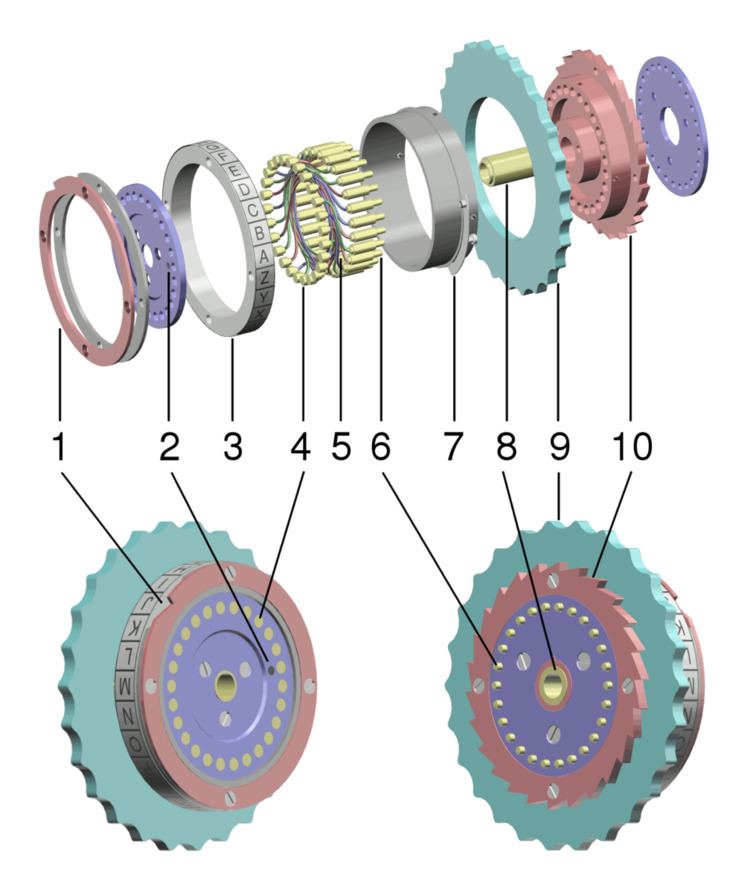 | ||
This article contains technical details about the rotors of the Enigma machine.
Contents
- Rotor electrical view
- Rotor offset
- Ring setting
- Rotor wiring tables
- Swiss K
- Turnover notch positions
- Normalized Enigma sequences
- Fourth rotor
- References
Understanding the way the machine encrypts requires taking into account the current position of each rotor, the ring setting and its internal wiring.
Rotor electrical view
Since the same wires are used for forwards and backwards legs, a major cryptographic weakness is that no letter can map to itself.
Rotor offset
In order to understand the effect of rotation on the rotors we demonstrate this by some examples.
As an example, let us take rotor type I of Enigma I (see table below) without any ring setting offset. You can see that an A is encoded as an E, a B encoded as a K, and a K is encoded as an N. Notice that every letter is encoded into another.
In the case of the reflectors, we take Wide B (Reflector B in the table below) where an A is returned as a Y and the Y is returned as an A. Notice that the wirings are connected as a loop between two letters.
When a rotor has stepped, you must take into account the offset to know what the output is, and where it enters the next rotor.
If for example rotor I is in the B-position, an A enters at the letter B which is wired to the K. Because of the offset this K enters the next rotor in the J position.
With the rotors I, II and III (from left to right), wide B-reflector, all ring settings in A-position, and start position AAA, typing AAAAA will produce the encoded sequence BDZGO.
Ring setting
The ring settings, or Ringstellung, are used to change the position of the internal wiring relative to the rotor. They do not change the notch or the alphabet ring on the exterior. Those are fixed to the rotor. Changing the ring setting will therefore change the positions of the wiring, relative to the turnover-point and start position.
The ring setting will rotate the wiring. Where rotor I in the A-position normally encodes an A into an E, with a ring setting offset B-02 it will be encoded into K
As mentioned before these encodings only happen after the key is pressed and the rotor has turned. Tracing the signal on the rotors AAA is therefore only possible if a key is pressed while the rotors were in the position AAZ.
With the rotors I, II, III (from left to right), wide B-reflector, all ring settings in B-position, and start position AAA, typing AAAAA will produce the encoded sequence EWTYX.
Rotor wiring tables
This table shows how the internal wiring connects the right side of the rotor (with the spring-loaded contacts) to the left side. Each rotor is a simple substitution cipher. The letters are listed as connected to alphabet order. If the first letter of a rotor is E, this means that the A is wired to the E. This does not mean that E is wired to A. This looped wiring is only the case with the reflectors.
Technical comments related to Enigma modifications 1939-1945.
Swiss K
Turnover notch positions
The single turnover notch positioned on the left side (plate connector side) of the rotor affected the stepping motion by engaging the ratchet teeth of the wheel to the left. Later rotors had two turnover notches. The table below lists the turnover notch point of each rotor.
Normalized Enigma sequences
In the following examples you can observe a normal step sequence and a double step sequence. The used rotors are (from left to right) I, II, III, with turnovers on Q, E and V. It is the right rotor's behavior we observe here (turnover V).
Normal sequence:Fourth rotor
The introduction of the fourth rotor was anticipated because captured material dated January 1941 had made reference to the development a fourth rotor wheel; indeed, the wiring of the new fourth rotor had already been worked out.
On 1 February 1942, the Enigma messages began to be encoded using a new Enigma version that had been brought into use. The previous 3-rotor Enigma model had been modified with the old reflector replaced by a thin rotor and a new thin reflector. Breaking Shark on 3-rotor bombes would have taken 50 to 100 times as long as an average Air Force or Army message. It seemed, therefore, that effective, fast, 4-rotor bombes were the only way forward. Encoding mistakes by cipher clerks allowed the British to determine the wiring of the new reflector and its rotor.
